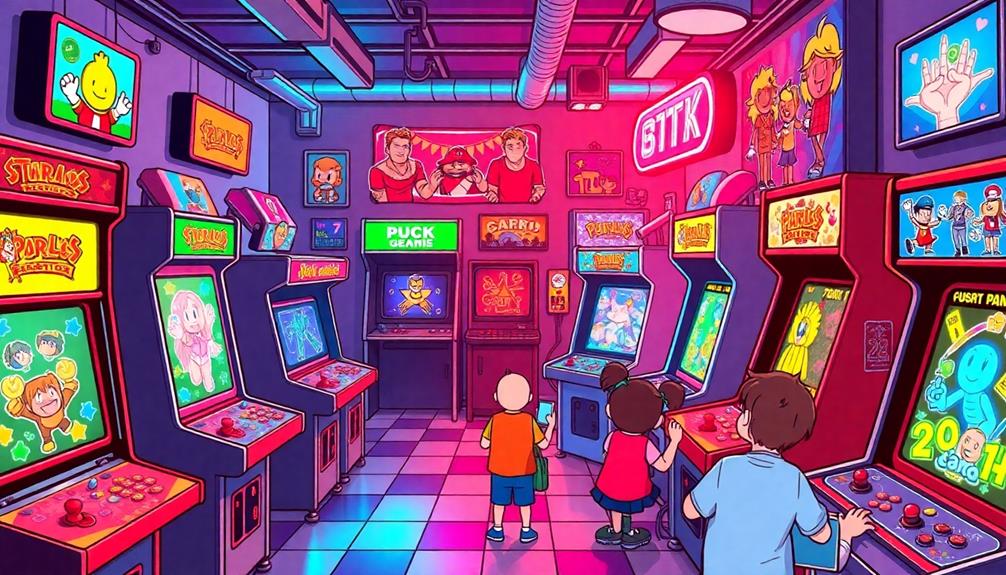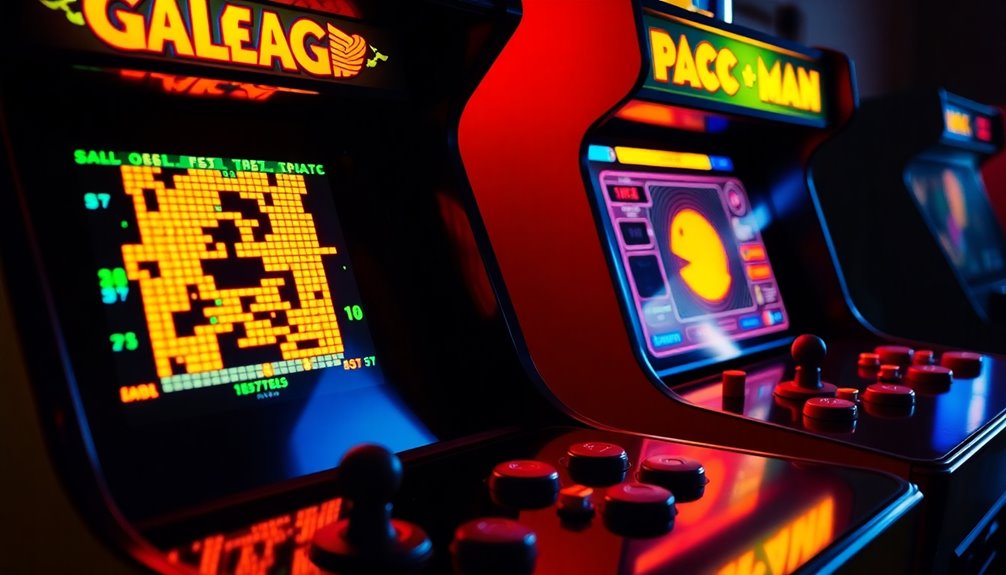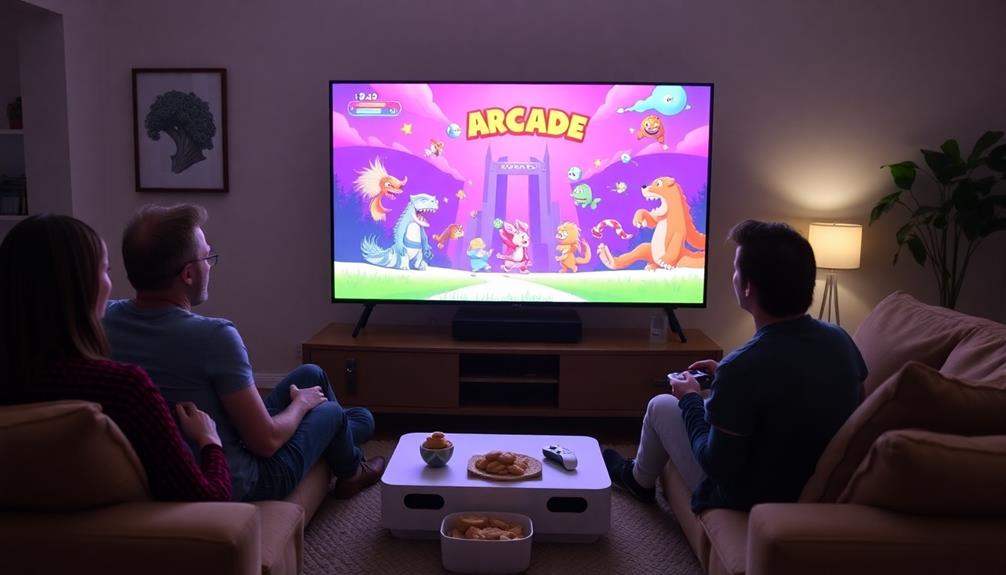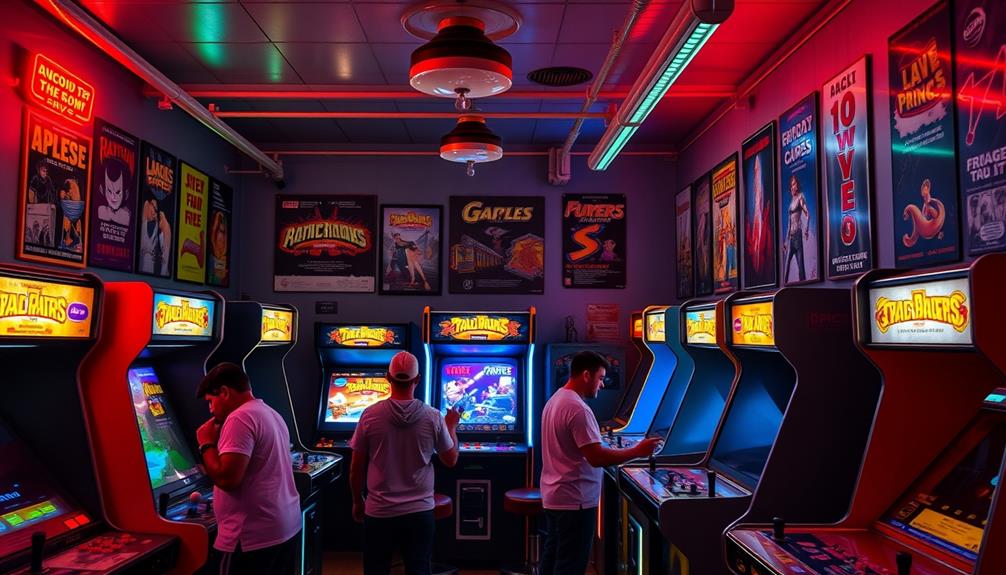Old arcade games often face varied outcomes. Some are left abandoned, covered in dust, and deteriorating from rust and mold, while others are given a second chance at life in retro bars or private collections. Fans of these games are eager to revitalize these classic machines, blending original components with modern technology. It’s common to see salvaged parts repurposed for new projects, preserving the nostalgia of the past. The increasing market value of certain games also drives collectors to seek them out, driven by emotional connections and shared memories. There is a lot to discover about the history of these cherished relics and their cultural significance.
Key Takeaways
- Old arcade games often fall into neglect, leading to deterioration from rust, mold, and vegetation infiltration.
- Many vintage machines become non-repairable, prompting collectors to salvage parts for repurposing.
- A growing interest in retro gaming fuels restoration efforts and market value for classic titles.
- Scarcity of original arcade games drives up prices and competition among collectors.
- Online communities and collector groups are essential for preserving and sharing knowledge about arcade game history.
Nature's Impact on Arcade Games
The inevitability of decay often underscores the fragility of human creations, and nowhere is this more evident than in abandoned arcade games. These neglected arcade machines, once vibrant symbols of retro gaming culture, now succumb to nature's relentless grip. Rust creeps over metal components, while mold flourishes in the dark corners of forgotten cabinets. Vegetation often weaves its way through the circuitry, a stark reminder of how quickly nature reclaims its territory.
The loss of these machines can also impact the availability of best arcade machines for home game rooms, as fewer original units remain for enthusiasts to restore or repurpose.
As you explore these decaying relics, you can't help but notice the striking contrast between their former glory and their current state. The bright colors of a once-thriving entertainment hub fade into muted tones, reflecting the transience of technology in the face of relentless entropy. Each deteriorating machine symbolizes the cultural artifacts that risk being lost forever if we neglect preservation.
The encroachment of nature on these arcade machines serves as a powerful reminder of the importance of safeguarding our retro gaming heritage. Without active efforts, the stories and experiences these machines once provided could vanish, leaving only memories of a vibrant past that time and nature will continue to erode.
The Role of Urban Explorers
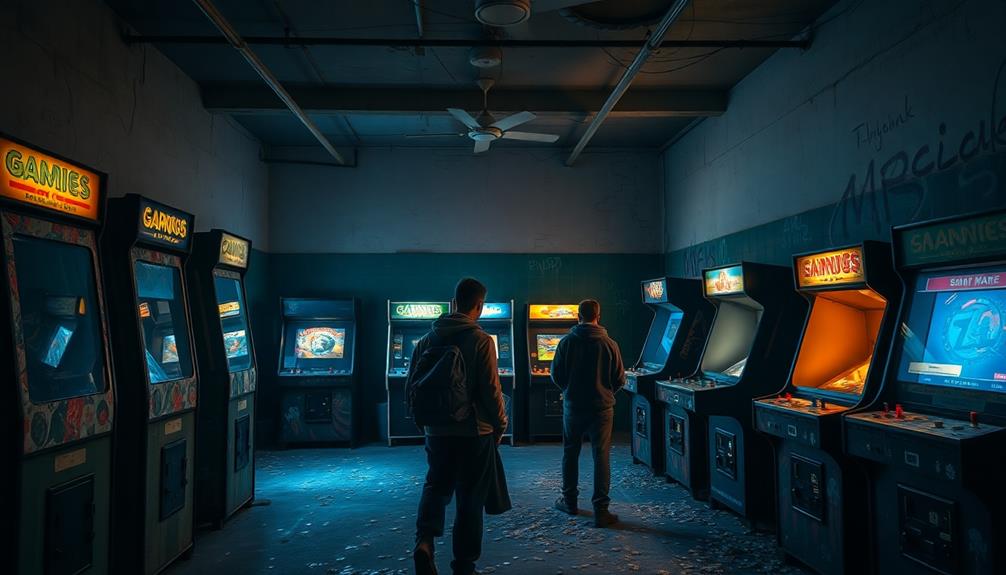
Urban explorers play an essential role in uncovering the stories behind abandoned arcade games, turning forgotten relics into points of interest that spark curiosity. These adventurous individuals document their finds, revealing the hidden histories and cultural significance of neglected machines. With each exploration, they capture the eerie beauty of decaying arcade games, showing how time and neglect have shaped these artifacts.
Their photography serves as a powerful visual reminder of the past, fueling public fascination and highlighting the importance of preserving gaming history.
| Aspect | Details |
|---|---|
| Purpose of Exploration | Document forgotten arcade games |
| Risks Involved | Traversing hazardous environments |
| Cultural Significance | Raising awareness of gaming history |
| Impact of Sharing | Sparking public curiosity |
| Eerie Beauty | Showcasing decay's visual impact |
Through their efforts, urban explorers shine a light on the need for active care of cultural artifacts, encouraging a greater appreciation for vintage arcade games. Their passion and dedication guarantee that these stories are not lost in time but instead celebrated and remembered.
Importance of Preservation

Preserving old arcade games is essential for maintaining an important part of our gaming heritage. When you neglect these arcade game cabinets, you risk losing cultural artifacts that tell the story of gaming's evolution.
Active preservation efforts are vital; they require time, attention, and resources, emphasizing that it's a collective responsibility to safeguard our technological heritage for future generations. Just as celebrity relationships like Jennifer Aniston and Brad Pitt's post-divorce connection demonstrate the importance of maintaining bonds, preserving arcade games showcases our commitment to honoring the past.
Abandoned arcade machines stand as stark reminders of the potential losses in gaming culture. They call for increased awareness and action towards their preservation.
Vintage arcade machines, like the Addams Family pinball that sold for £10,000, highlight their rising value and the significance of maintaining these historical pieces.
Engaging with online communities and forums can deepen your appreciation for arcade game preservation. These platforms foster discussions and encourage collective efforts to maintain the legacy of these games.
Cultural Significance of Arcades

Arcades have always been more than just places to play games; they've served as social hubs where friendships formed over high scores and competition. The cultural significance of arcades during their peak in the late 1970s to early 1980s shaped an entire generation's gaming experience. Iconic titles like Pac-Man and Donkey Kong not only provided entertainment but also created lasting memories and community connections.
Additionally, the introduction of innovative games such as pinball machines, which began to flourish in the 1940s and 1950s, contributed to the rich tapestry of arcade culture, making these venues vibrant places for social interaction and competition. The progression of pinball machine technology further enhanced the gaming experience, allowing players to enjoy dynamic gameplay and engaging challenges.
As home consoles gained popularity in the late 80s, the decline of arcade culture reflected a shift in children's gaming habits. However, the nostalgia for classic arcade games still influences modern game design. You might notice that many contemporary developers draw inspiration from the retro aesthetics and mechanics that defined that era.
Abandoned arcade machines serve as reminders of those vibrant social gaming experiences, acting as cultural artifacts that connect generations of players. Preserving this history is essential, ensuring that future generations understand the impact these games had on social interactions and the evolution of gaming itself.
Trends in Vintage Arcade Machines

A growing fascination with vintage arcade machines is sweeping across communities, reigniting interest in these nostalgic treasures. You might've noticed that about 50% of these machines are now sold to retro bars and modern arcades, creating a vibrant atmosphere for gamers.
This trend mirrors the resurgence seen in sneaker culture, where Nike Tech dominates by merging comfort, style, and sustainability. Private collectors are also snatching up classic arcade machines, driving up market values considerably. For instance, high-demand titles like the Addams Family pinball can sell for as much as £10,000, reflecting the deep nostalgia many feel for these games.
Online platforms like Discord and UKVAC forums have become bustling hubs for collectors, where you can exchange valuable information and resources about vintage arcade machines. The rise of retro arcade bars not only fuels interest but also intensifies competition among private collectors and business owners.
This competition has resulted in a thriving marketplace, making well-maintained classic games even more sought after. As you explore this world, you'll find that the restoration of vintage arcade machines often requires balancing original components with modern technology, showing just how dedicated enthusiasts are to preserving these cultural artifacts.
Restoration Challenges Faced

Restoring vintage arcade machines presents numerous challenges that can frustrate even the most dedicated enthusiasts. Each machine arrives in varying conditions, often requiring extensive repairs.
You'll need to assess components and functionality thoroughly to guarantee a successful restoration. Additionally, understanding the nuances of cookie categories can offer insights into the level of detail required in restoration efforts.
Here are three key challenges you might face:
- Balancing Authenticity and Functionality: You'll often grapple with the decision to preserve original parts versus replacing non-functional components with modern replicas. Finding that balance is essential for maintaining the machine's integrity.
- Sourcing Unique Parts: Many vintage arcade machines contain rare components that are tough to source. With specialty engineers who once maintained these machines having largely retired, the search for original parts can become an intimidating task.
- Avoiding Poor Restorations: Unfortunately, some restorations have resulted in significant damage to original machines. This makes locating classic games in unaltered condition increasingly difficult.
Even creative solutions, like tube swaps for CRT monitors, often fall short of true restoration standards, complicating your efforts to maintain authenticity.
Navigating these challenges requires patience and a deep commitment to preserving arcade history.
Salvaging Parts for Repurposing
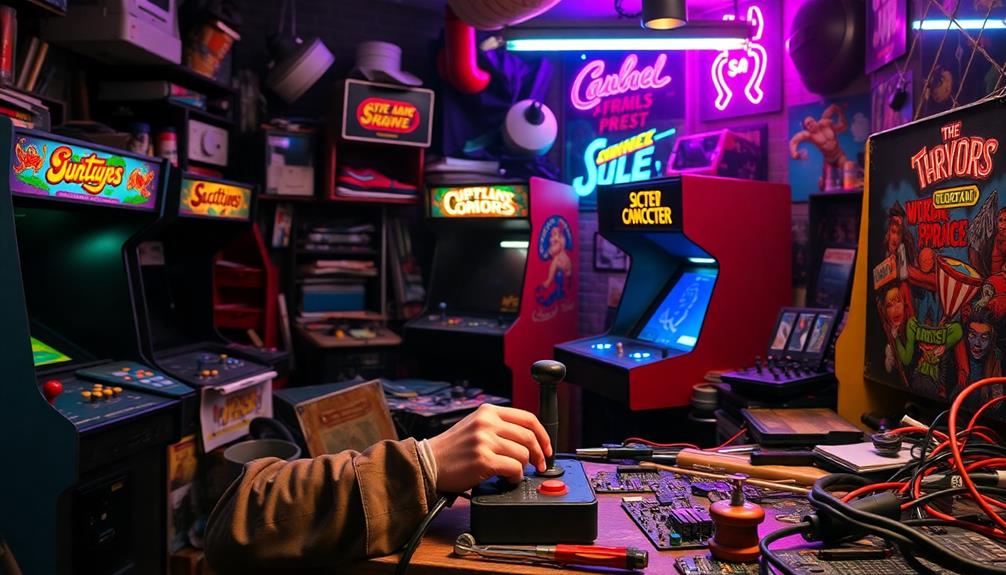
Vintage arcade machines often face their demise when they become non-repairable, leading many enthusiasts to strip them for valuable components. Salvaging parts like circuit boards, monitors, and joysticks has become increasingly popular, especially since many of these components are no longer manufactured.
Many collectors also seek out parts from classic pinball machines, as they offer unique features and advanced technology that can enhance custom projects like best rated pinball machines. As you immerse yourself in this process, you'll discover that stripped cabinets can be creatively repurposed into custom arcade setups, keeping the spirit of retro gaming alive while embracing modern technology.
Repurposing efforts can transform old machines into unique cocktail cabinets or stylish media stands, greatly contributing to waste reduction and preventing landfill disposal. Not only do these projects breathe new life into discarded machines, but salvaged parts can also increase in value due to their scarcity.
This trend highlights a growing sustainability movement within the gaming community, where reusing components takes precedence over simple disposal.
High-Value Collectible Machines

Salvaging parts from old arcade machines not only helps in repurposing but also opens up a fascinating world of high-value collectible machines.
As a collector, you'll find that certain arcade games command impressive prices, especially those tied to popular franchises. The market for collectible machines has surged, thanks to nostalgia and rarity, making it essential to understand the nuances of yoga for back pain when considering the physical demands of maintaining and restoring these machines.
Here are three high-value arcade games to keep an eye on:
- Star Wars Battle Pod – Selling for around £10,000, this immersive experience is a must-have for fans.
- X-Files Pinball – Valued at approximately £3,500, this unique machine is highly sought after due to its cult status.
- Atari's Tempest – A classic from the late 1970s, its cultural significance has led to significant appreciation in value.
Collectors are increasingly drawn to original machines that are unique and well-maintained.
The COVID-19 pandemic has fueled interest in vintage titles for home entertainment, creating a vibrant community around high-value arcade games.
If you're considering diving into this hobby, focusing on rarity and condition will help you build an impressive collection.
Nostalgia and Market Trends
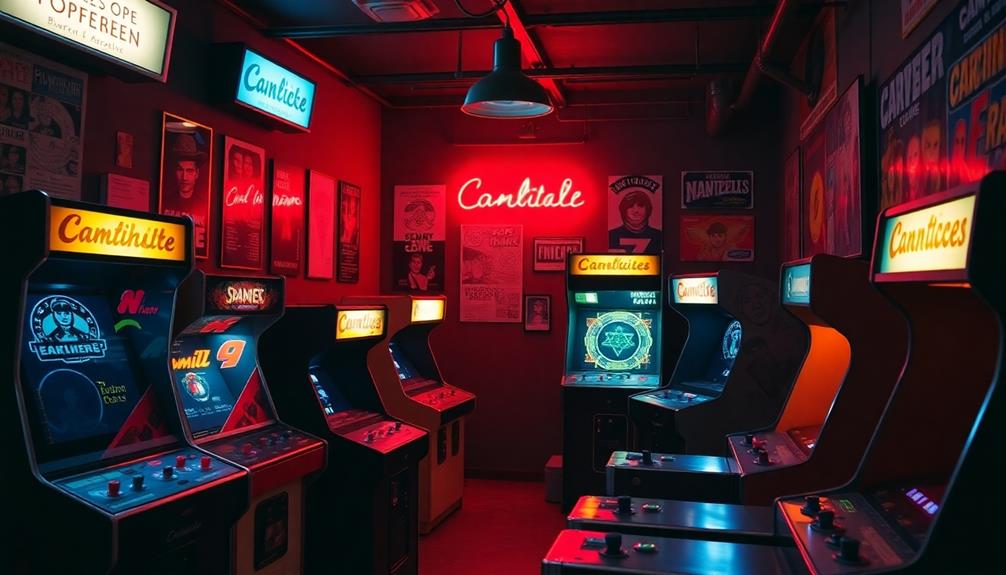
You might've noticed how nostalgia for classic arcade games is driving prices up, especially for rare titles.
The emotional connection to these games often mirrors the cherished memories found in Paula Deen's Wedding Highlights, where love and tradition come together.
As collectors compete fiercely for these scarce items, the market dynamics shift, making it harder to find that coveted game from your childhood.
This growing interest isn't just about play; it's also tied to investment strategies and the emotional pull of shared memories.
Rising Nostalgia Effects
Fueled by a wave of nostalgia, collectors are driving a resurgence in the arcade game market, particularly for titles from the late 1970s to mid-1990s.
As you immerse yourself in collecting, you'll notice how this nostalgia translates into rising prices and increased interest. Studies suggest a correlation between cultural beliefs and astrological compatibility which may also influence how individuals perceive the value of nostalgic items.
Here are three key factors to reflect on:
- Record Sales: The sale of a sealed Super Mario Bros. for $2 million in 2021 highlights how nostalgia can skyrocket collectible values.
- Market Scarcity: Many collectors are holding onto their games longer, reducing availability and further inflating prices.
- Cultural Influence: Media portrayals in films and books elevate the status of arcade games, stirring interest and driving up demand.
With Generation X and Y enjoying economic recovery, they're more willing to spend their disposable income on these childhood treasures.
This nostalgia-driven collecting trend isn't just a passing phase; it's reshaping the market and creating an exciting landscape for both new and seasoned collectors.
If you're pondering joining this nostalgic journey, be prepared to witness the evolving dynamics of the arcade game market.
Collector Competition Dynamics
In the ever-evolving landscape of arcade game collecting, competition among enthusiasts is intensifying at an unprecedented pace. The nostalgia for classic arcade games from the late 1970s to mid-1990s has sparked a frenzy, pushing prices for collectible items to new heights. This surge in demand mirrors trends seen in alternative investments, such as gold IRA scams, where market dynamics play an essential role in shaping collector behavior.
You've likely heard about the sealed Super Mario Bros. selling for a jaw-dropping $2 million in 2021, a clear indicator of how nostalgia and market dynamics intertwine.
As collector competition grows, more individuals are holding onto their prized arcade titles, greatly reducing the availability of classic arcade games in the market. This scarcity drives up demand and, consequently, prices. Serious collectors wield substantial influence over market trends, particularly for high-demand arcade titles, where limited availability makes certain games even more valuable over time.
Moreover, media representations, such as films and books, have heightened the allure of arcade collecting, further fueling interest among potential collectors.
As you immerse yourself in this competitive landscape, be prepared for the challenges and opportunities that come with steering through the growing market for classic arcade games. The thrill of the hunt is alive and well, but so is the competition!
Classic Titles Scarcity
Scarcity in classic arcade titles is reshaping the collectibles market, driven by a surge of nostalgia that has collectors clamoring for iconic games from the late 1970s to mid-1990s.
As demand skyrockets, prices are following suit, transforming these classic titles into valuable assets. Here are three key factors contributing to this scarcity:
- Limited Supply: Many classic arcade games were produced in small quantities, meaning fewer surviving units are available for collectors today.
- Collector Competition: The competition among enthusiasts has intensified, prompting collectors to hold onto their prized titles rather than sell them. This reduces the overall availability in the market.
- Media Influence: Movies, books, and documentaries celebrating retro gaming have heightened interest in these classic titles, further driving prices up and creating a sense of urgency among buyers.
The sale of a sealed Super Mario Bros. for $2 million in 2021 exemplifies this trend.
With Generation X and Y now having increased disposable incomes, the drive for nostalgic collectibles only intensifies, making classic arcade titles more scarce and coveted than ever.
Future of Arcade Game Preservation

As you explore the future of arcade game preservation, you'll notice a growing community of collectors dedicated to maintaining these iconic machines.
You'll face challenges in restoration, balancing original parts with modern technology, all while recognizing the cultural significance of these games.
Together, you can contribute to preserving the rich history of arcade gaming for future generations.
Growing Collector Communities
Amid the growing nostalgia for retro gaming, collector communities are thriving like never before, actively working to preserve the legacy of vintage arcade machines. The resurgence of interest has turned these communities into vibrant hubs, where people share a passion for gaming history. Approximately 50% of vintage machines sold now find homes in retro bars and modern arcades, highlighting this trend.
Here are three ways collector communities are making an impact:
- Networking: Online platforms like Discord and UKVAC forums allow collectors to connect, share restoration tips, and source rare titles. This collaboration strengthens their efforts in preservation.
- Nostalgia: The COVID-19 pandemic has reignited interest in arcade machines as home entertainment, reminding many of their childhood experiences. This emotional connection fuels the desire to collect.
- Investment: Economic recovery post-2007 has empowered Generation X and Y to invest in collectibles, including vintage arcade games, as they seek socially accepted hobbies that resonate with their past.
As the rarity of certain arcade machines increases, the future of these collector communities looks promising, ensuring that the cultural significance of arcade games remains alive for generations to come.
Restoration Techniques and Challenges
Restoring vintage arcade games can feel like a labor of love for many collectors, as they navigate the intricate process of bringing these machines back to life. You'll begin by evaluating the game's condition, determining necessary repairs, and deciding whether to preserve original components or replace them with modern replicas.
Finding specialty engineers who understand the proprietary hardware from the 1990s can be a challenge, as many have retired. For non-repairable machines, you might find yourself stripping valuable components like circuit boards and monitors, which are in high demand within the collector market.
Creative repurposing of stripped cabinets into custom setups reflects a growing trend toward sustainability in gaming. Still, sourcing unique parts can be tricky, and poor restorations can lead to further difficulties in preservation.
Here's a quick look at the restoration process:
| Step | Description | Challenge |
|---|---|---|
| Evaluation | Evaluate the game's condition | Finding knowledgeable techs |
| Repairs | Determine necessary fixes | Balancing original vs. replica |
| Component Stripping | Salvage parts from non-repairable machines | Risk of losing valuable parts |
| Repurposing | Create new setups from stripped cabinets | Maintaining sustainability |
Informed decisions are essential in the world of vintage video arcade games.
Cultural Significance of Preservation
Why is preserving arcade games so crucial to our cultural heritage? These machines aren't just relics; they're milestones that shaped the gaming landscape and evoke powerful nostalgia. As you engage with these vintage arcade games, you connect with a significant part of entertainment history.
Here are three reasons why preservation matters:
- Cultural Memory: Arcade games represent shared experiences across generations, making them crucial pieces of our collective memory.
- Economic Value: Many vintage arcade machines have skyrocketed in market value, turning into coveted collectibles that warrant preservation efforts.
- Unique Artifacts: Components from older arcade machines are often irreplaceable, and their preservation helps prevent the loss of critical gaming history.
The rise of retro gaming and barcades has encouraged collaboration among collectors and preservationists, ensuring these classic games are restored and appreciated in social settings.
Ongoing discussions about the sustainability of the collectibles market further emphasize the importance of these arcade machines as cultural artifacts. By preserving them, you help maintain a rich legacy that continues to influence gaming today and into the future.
Frequently Asked Questions
What Happens to Old Arcade Machines?
Old arcade machines often sit neglected, becoming relics of the past. You might see some restored by collectors, while others get stripped for parts. Many end up in eco-friendly junk removal, ensuring proper disposal.
Do Old Arcades Still Exist?
Yes, old arcades still exist! You'll find retro-themed venues buzzing with laughter, clinking glasses, and the familiar sounds of classic games. People gather, reliving nostalgia, sharing stories, and enjoying the vibrant atmosphere together.
Why Are Old Arcade Games so Hard?
Old arcade games are tough because they demand skill and precision. You've gotta master complex controls, navigate unpredictable patterns, and deal with limited guidance, which can make each victory feel even more rewarding. During the golden age of arcade games, players would spend hours perfecting their techniques in order to reach the top of the leaderboard. The competitive nature of these games often led to gatherings of friends and strangers alike, all vying for the chance to be crowned the best. Despite the challenges, the thrill of mastering an old arcade game and earning a high score is an experience that many gamers still cherish to this day.
Why Are There No Arcades Anymore?
You'll notice that arcades faded as home consoles took over, shopping malls closed, and online gaming surged. The unique experiences once offered diminished, leaving many classic games in private collections rather than bustling arcade halls.
Conclusion
As you wander through a forgotten arcade, you might stumble upon an old Pac-Man machine, its screen flickering faintly. Coincidentally, you're reminded of childhood memories spent battling friends for high scores. This chance encounter highlights the importance of preserving these nostalgic treasures. By salvaging parts and restoring vintage machines, you not only honor the past but also guarantee that future generations can experience the joy and cultural significance of arcade games. Let's keep the magic alive together!

